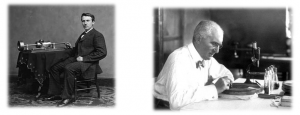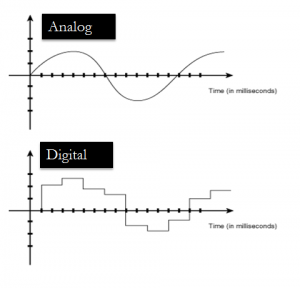Voice recording was first introduced in 1877 by Thomas Edison and later perfected in 1887 by Emil Berliner. Since then, there have been incredible technological advancements made to capturing audio. Fast forward 136 years, the hot topic is whether to choose an analog or a digital device. When in the market for a voice recorder, many will ask “why should I buy or switch to digital voice recorders”. This comparative review will explain the advantages of digital voice recorders over analog voice recorders.
Storage Capacity: These days most digital voice recorders use removable media, which means they use memory cards. This gives the user the option to choose how much memory they want. SD cards are the most widely used memory type in digital voice recorders today. Some digital voice recorders can accept an 8GB memory card, that’s a lot of storage capacity. The available recording time on a memory card will depend on the quality of the recording. The higher quality of the recording; the less recording time available. On an 8GB card, if you record in high-quality, you will have approximately 631 hours 15 minutes of available recording time, whereas you will have 1,293 hours 15 minutes available in a standard play mode. The standard recording time for a cassette tape is 60 minutes. Other digital voice recorders will use internal or flash memory, these digital voice recorders have the memory built into the recorder. The available flash memory varies between manufacturers. The average is 2GB, which calculates to 157 hours 55 minutes in high-quality mode and 323 hours 35 minutes in standard play mode. Either way you go, digital far surpasses the capabilities of analog.
Durability: Durability and reliability are factors we should all consider when making any purchase, especially with electronic devices. Analog recorders have proven to be durable. I still have an old Sony M-540V microcassette recorder which has served me well over the years. Although my M-540V has lasted, it’s more likely to fail at some point due to its design. Analog recorders are made of several individual moving components. When you press play or record, a lever activates a motor which tell a particular gear to perform an action based on which button you’ve pressed. With this many moving parts, the fail rate increases whereas digital voice recorders have no moving parts. They were designed to last with virtually no “wear and tear” over time. As an authorized service center for Olympus & Philips, we’ve seen our share of repairs. The need for analog repairs is far more common than digital repairs.
Convenience: When thinking of the advantages and disadvantages of analog versus digital, convenience came to mind several times. As a distributor of analog and digital equipment, I have the advantage of knowing what sells and what’s available to sell. Analog equipment is still available, but not as readily available and digital devices. Several manufacturers have discontinued production of analog equipment all together, others have simply produced less. With that said, availability is the first convenience of digital voice recorders; you can find digital recorders and memory cards just about everywhere. Another convenience of digital voice recorders is PC connectivity. A majority of DVRs today have a USB port to allow connection to any PC. Some of the better DVRs also include a docking station to further increase the ease-of-use.
Portability: Being that both analog and digital voice recorders are wireless, they are both portable, however; digital voice recorders are smaller and lighter than analog recorders. The average digital voice recorder is approximately half the size of cassette recorders. Overall, technology has advanced to the point where digital devices are smaller and lighter than ever. We will compare apples-to-apples, a Sony analog recorder versus a Sony digital recorder.
[one_half first]
Analog:
- Sony M-540v
- Weight: 4 3/8 oz
- Dimensions: 4 ¾ x 2 ½ x 15/16”
- (121.5 x 62.2 x 24.3 mm)
[/one_half]
[one_half]
Digital:
- Sony ICD-SX700
- Weight: 2 oz
- Dimensions: 1 ¼ x 4 ¾ x 5/8”
- (30.8 x 119.3 x 14.9 mm)
[/one_half]
Sound: It’s not really fair to compare the sound of analog versus that of digital. We’re talking magnetic tape versus binary code. For recording voice, digital will win every time. In the music venue, some instruments (particularly percussion) respond better to analog recording, essentially everything else is better with digital. For the sake of your attention span and fear of boring you to death, I will not go into depth on the specific variations of analog and digital. I will say that digital offers a higher sampling rate and higher fidelity. Many digital voice recorders record with CD quality (44.1 kHz) and are able to filter out background noise.
Navigation & Control: A majority of analog recorders have the ability to record, play, rewind & fast forward, just like the cassette players in vehicles. If you wanted to go back to a particular song, you would press the rewind button until you found the right spot. For most of us, it would take a few tries before we found the right spot. It’s the same for analog recorders. Now, compare that to a CD player; where you have the ability to change songs by the press of a button. Digital voice recorders offer several advantages in regards to navigating and controlling your recordings. You have the ability to insert index marks (bookmarks), easily navigate through your recorders and even mark files with priority.
Data Storage: In these times of technological advances, we’ve come to expect more out of our devices. Example: mobile phones nowadays are a hybrid of camera, calendar, computer, phone, music player and gaming system. Digital voice recorders offer the advantage of being a data storage device in addition to a digital voice recorder. You can store documents, photos, presentations and music in addition to your audio recordings.
Features: Biometric fingerprint reading, barcode scanning, programmable buttons, backlight LCD display, indexing, author IDs, worktypes, MP3 support, conference/dictation modes, USB charging, file encryption, out-touch key assignments, smart buttons… Need I say more?
Software: Many of today’s digital voice recorders are packaged with software that allows control and management of your audio files. Overtime, the DVR software has transformed into a workflow management system. Auto-downloading, auto-converting, emailing, networking, auto FTP-transmission, audio and visual notifications, auto-routing, customizable panels, auto-firmware and software updates and auto-transcription using speech recognition software are just a few of the available features within the various software available with digital voice recorders.


